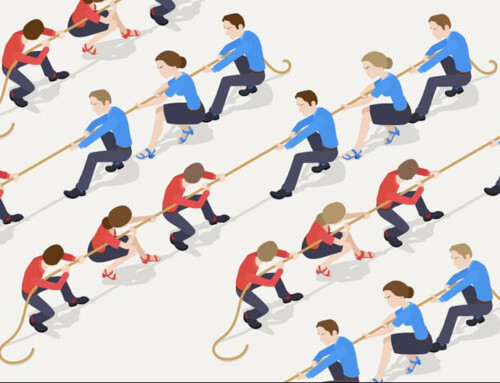Have you ever tried to make a slight change to your behavior? Maybe it’s a New Year’s Resolution. Perhaps you would like to do something to strengthen your career advantage. It could be that you want to make a difference to show yourself (or others) that something is possible or improve someone else’s perspective. Whatever your reason, change can be complicated, and can even seem impossible.
However, change doesn’t have to start with something big. As the Chinese proverb says, “a journey of a thousand miles begins with a single step.”
One way to start that first step is to look at your habits. Habits are tendencies you already have or behavior that you do on a regular, repeated basis without even thinking. For example, when you got up this morning, either you made or didn’t make your bed; you likely brushed your teeth, showered, and got dressed, based on habits you already have within your daily routine or habit box.
Some habits can be bad such as smoking, overspending, snapping gum, cracking knuckles, or speeding on the commute to work. On the other hand, habits can also be good, such as brushing teeth, reading the latest industry news, taking the dog for a walk, or observing traffic laws.
Consider, for a moment, your good habits. What do those look like for you in the workplace? What are your good habits as a person? Here are some examples that might help:
| In the workplace | As a person |
|
|
Right now, you might be wondering, what does pointing out existing good habits have to do with supercharging change?
That’s precisely where habit stacking comes into play.
What is habit stacking?
Habit stacking is a strategy for creating new habits by building on existing actions or habits already in place. It’s a term coined by S.J Scott in his book, Habit Stacking. The concept of piggybacking on already established behaviors has been studied by other behavior experts as well.
BJ Fogg, Ph.D., a behavioral scientist, as part of his Tiny Habits program utilizes habit stacking as part of his implementation intention process. James Clear, a habit/behavior expert, and best-selling author is another proponent of habit stacking. He includes the concept in his book Atomic Habits and Clear Habit Journal System.
Isn’t habit stacking just a checklist?
Habit stacking isn’t the same as a checklist. It’s better. Habit stacks improve productivity and minimize the complexity of everyday life because everything becomes routine. Let’s break the differences down a bit further.
A checklist is a list of things that need to be done. For a checklist to be effective and garner results, it needs a reminder as well as taking action and ensuring follow-through.
On the other hand, a habit stack is a little “program” that reminds you when and how to do what you need to do. Plus, it’s easy to remember since a habit stack never takes more than 5 minutes to initiate the “program” chain. (1)
Think of habit stacking like an apprentice or mentor program for habits. A single habit acts as a buddy system to a new habit so that the new habit is easy to learn and more likely to “stick.” Habit stacks are really very simple. You find an existing good habit that’s already a no-brainer, and tack on a new, desired change. An easy formula for a habit stack is:
Before/After/While [EXISTING GOOD HABIT or “HABIT ANCHOR”],
I will [DESIRED NEW HABIT].
Some examples are:
- After brushing my teeth, I will not eat or drink for 20 minutes.
- Before doing exercises, I will practice slow breathing.
- While drinking my morning coffee, I will read the latest industry news.
Why is habit stacking effective?
It’s less overwhelming than building something from scratch.
Designer dupes, that is, fashion resembling expensive couture pieces, are popular (and legal) for a reason. These designers don’t try to pass themselves off as a designer label. Instead, they are inspired by couture fashion and create similar designs. Habit stacking is similar to a designer dupe (a desired new habit) since it uses something already couture (a successful, good habit) to help it succeed.
It’s a reminder system.
There’s no need for alarms, tying a string around a finger, or asking your buddy Betsy to check-in. The structure of habit stacking is created around what already exists, so the reminder is already built-in. Habit stacking doesn’t need bells or whistles because it’s using the best custom reminder system that’s already in place – YOU!
It’s an upgrade to something already in place.
Whether you’ve made a purchase online or driven through a fast-food lane, you’ve likely seen an option to include something extra with your purchase. For example: Would you like fries with that burger? Would you like to supersize your drink? Do you need an extended warranty? Others have also purchased a case, backpack, cords, etc. with their purchase; would you like these too? Habit stacking is simply your “would you like fries with that” upgrade to an existing habit.
5 Tips to Make Habit Stacking Effective
Set yourself up for success
The best way to make habit stacking effective is to start small rather than think about massive changes. Remember the Chinese proverb: “A journey of a thousand miles begins with a single step.” So instead of choosing a large change, think about breaking a big change into smaller, bite-size changes.
For example: You want to start making more sales outreach and follow-ups. You want to start a habit of tackling this to increase your sales effectiveness, quotas, etc. Instead of determining that you want to do everything by 9 AM every morning, it might be better to start with smaller aspirations. Consider what’s realistic such as what you can really do every morning before 9 AM. Then break it down into smaller tasks that can be habit stacked, such as:
| Habit Anchor | Desired New Habit |
| While I brush my teeth | I will listen to industry news alerts about three companies I want to reach out to this week. |
| Before I sit down to drink my morning coffee | I will write down any information I feel is relevant to warm outreach. |
| After I arrive early to work | I will research and find the most likely contacts in the three companies I want to reach this week. |
Match existing habits with new goals.
Make a list of the new goals you have. Are these things that need to be done daily? Weekly? Monthly? Then think about the existing habits you have. If you have an existing habit, such as brushing your teeth daily, this habit would be best stacked with a new habit that is also a daily activity. The same is true if an existing habit is something weekly such as running a weekly quota report. Then this habit should be stacked with a new habit that is a weekly new goal.
Another factor to consider is the time of day. Morning activities should be stacked with other morning habits. The same for afternoon or evening habits. Matching new habits with existing ones may take some time, but it will be worth the extra effort.
Add contingency plans
It’s likely that there will be bad weather, you’ll be sick or need to travel, you will be pulled into a meeting, or something else will throw your habit stacking plans off kilter. In this case, what’s the alternate plan?
For example, you’ve stacked your new habit, researching contacts for outreach, with your habit anchor of arriving to work early. But upon walking in the door, your boss greets you with an unexpected meeting about one of the top accounts in your portfolio.
What’s your contingency plan? Will you postpone research until the next morning when you arrive at work? Skip it all together? Add the research to be done at lunch? Tack them on to the end-of-the-day activities? Do the research when you get home?
This is an example of how contingency planning can help iron out needs before you need them.
Utilize the 21/90 Rule to Gauge Progress
In the 1960s, Dr. Maxwell Maltz wrote a self-help book, Psycho-Cybernetics, A New Way to Get More Living Out of Life. He suggested that it takes 21 days to shake off an old pattern and 90 days to develop a new lifestyle. However, research in 2009 indicated that forming a new habit takes an average of 66 days but could take as long as 8.5 months. (2) While there’s no definite hard and fast rule about when new habits form, having a timeline ensures there’s a goal. Additionally, you will know when a new habit is ready to stand on its own.
Evaluate your habit anchor
If you notice that your progress is being hindered because your new habit is attached to a habit anchor that is constantly changing, you may need to adjust your habit stack. Using the examples above, if you’re always on the go in the morning, and have difficulty sitting down to sip a cup of coffee, your three habit stacks need revised habit anchors. Perhaps they would be better suited while you’re waiting in line at the Starbucks’ drive-thru, or you switch your strategy to reading audio mode with voice commands on your morning commute.
The logic behind habit stacking is straightforward. By starting with established habits and adding new, desired ones, you can build on successful habits to motivate and develop more significant behaviors.
Are you seeking ideas to reward your employees and boost motivation among them? If so, contact Gavel International to learn more about group travel incentive programs.
_______________________
SOURCES:
- J. Scott from Habit Stacking, 2017
- https://psychcentral.com/blog/need-to-form-a-new-habit-66-days
- Unlocking Excellence: The 7 Traits of Top Performers and Their Impact - April 14, 2025
- Why Content Is Essential for Driving Leads – and How to Create Content That Does - March 3, 2025
- Branding vs. SEO: Striking the Perfect Balance - February 10, 2025






